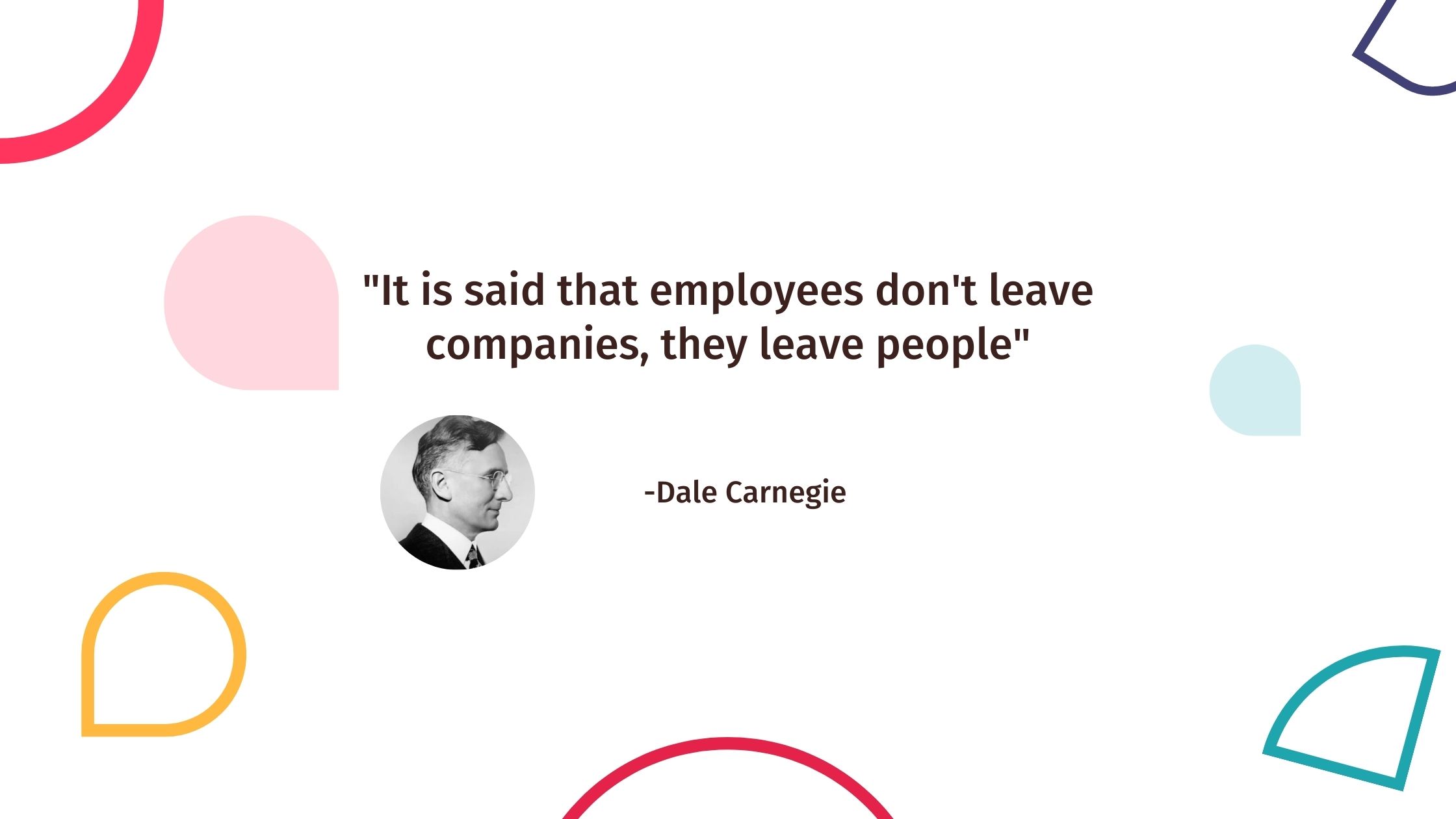As “a small leak will sink a great ship,” a high turnover rate can bring down a great workforce. While turnover is a normal part of any organization, excessive talent loss can do serious damage. For this reason, it is important to understand how to calculate the turnover rate of your company and recognize some of the causes of high turnover.
Over the past year, many companies have experienced a record amount of employee resignations.
Thankfully, there are strategies that HR can adopt to manage employee turnover. Often, turnover is a symptom of underlying dysfunction in the company culture.
This article will help you to diagnose the causes of turnover and develop a working strategy for your organization.
- What is a Turnover Rate?
- What is a High Turnover Rate?
- How to Calculate Turnover Rate
- Top Reasons for Employee Turnover
- The Impact of High Staff Turnover
- Turnover Costs and Losses
- How to Reduce Employee Turnover
- Measure your turnover rate with HR analytics software 📊
What is a Turnover Rate?
The turnover rate reflects the number of employees who have left over a certain period. It is one of the most important HR KPIs, as it reflects the overall health and stability of your company. Generally, the turnover rate is calculated with workforce data over the course of a year.
As many HR professionals know, the reasons for employee departure are countless. They might include resignation, termination, health reasons, or retirement. However, the turnover rate should not be confused with the attrition rate, which reflects unreplaced employee departure.
HR professionals can calculate employee turnover by department, by position, or by any category of their choosing. When there are vacancies that frequently need to be filled, it is said that there is a high turnover rate.
There are two distinct types of employee turnover, voluntary rotation, and involuntary rotation.
Voluntary Turnover
As the name states, this kind of job rotation occurs when an employee voluntarily leaves the company.
There are various causes of voluntary turnover. Some of the most common reasons for voluntary employee departure include
- A more competitive job offer
- Hostility with coworkers
- Feelings of underappreciation
- Poor compensation and/or benefits
- Feelings of exclusion
Although voluntary turnover is sometimes inevitable, HR can help to reduce some of these causal factors. It should be a goal to work towards a healthy, inclusive, and comfortable environment for employees.
Involuntary Turnover
When a worker is unwillingly terminated from the company, it is considered to be involuntary rotation.
Although it may not seem obvious, there are ways to reduce involuntary termination. In order to reduce involuntary turnover, HR can use people analytics to determine the causes of the termination. Was it due to inadequate training or tools? Are there better ways of supporting team members who are unsure of their role?
Involuntary rotations can’t be avoided 100%, but it’s best to minimize them as much as possible.
What is a High Turnover Rate?
High turnover occurs when a position is frequently vacant. High rotation means the position is vacated and filled repeatedly.
A high employee rotation has serious negative effects on a company. If there is a high rate of turnover and rotation, it is crucial to find out why it is occurring.
In order to prevent high turnover, it is necessary to calculate the turnover rate at your company. Then, you can take action and make the required adjustments to lower it.
How to Calculate Turnover Rate
To calculate the turnover rate you need the number of employees who leave and are replaced in a given timeframe. Like many other metrics used in HR reports, employee turnover reflects data collected over the course of a year.
Calculation for Turnover Rate
To calculate the turnover rate, you need the following:
- Number of employees who left within a given period
- The average number of employees within a given period
The formula for calculating the turnover rate is as follows.
Turnover rate (%) = (Number of Leavers/Avg. Number of Employees) x 100
Calculating the average number of employees is simple. First, add together the following
(Employees at the beginning of the period + Employees at the end of the Period)/2
Voila! Ready to plug into the turnover rate calculation!
Turnover Rate Calculations: Example
Let’s try with an example. If a 200 person company hired 20 and lost 10 within a year, what would the annual turnover rate look like?
First, calculate the average number of employees:
(200+220)/2 = 210
Now, let’s put the average into the turnover rate formula:
Turnover rate (%) = (10/210) x 100 = Approximately 4.76%
Once you have the results, you can analyze them and see if you fall into the standard turnover rate range. Depending on the type of business, and its nature, the average turnover rate will differ.
Keep in mind that a turnover rate of 0% is not necessarily good. Although it means that there is no problem with retaining talent, it might point towards an inability to evolve in the long term.
Reasons for High Turnover Rate
Sometimes employees choose to leave. It is inevitable. However, departures may stem from company policies and practices. Therefore, there are ways to prevent talent loss.
It’s always worth it to ask, how can I prevent employee turnover?
Here are some of the most common causes of turnover and tips on how to reduce the likelihood of turnover occurring.
 Turnover and Poor Management
Turnover and Poor Management
Frequently, talent is lost due to ineffective management. Aside from creating turnover-related problems, poor management can damage the overall health of your workforce.
Employees who choose to leave due to their managers are often unable to cope with the following qualities.
- Micromanagement
- Unconstructive communication
- Unfocused planning
Solution: In order to boost confidence and promote clarity, hold extra trainings for new managers. Make sure that new team members and their managers are well informed of their exact responsibilities. A great way to clarify goals and progress is with OKRs. These can help to keep everyone on the same page.
Turnover and Lack of Growth Opportunites
No one likes to feel stuck in their personal or professional lives. Most people search for ways to learn new skills and develop and evolve in their positions.
Ultimately, the gains and losses of the company are tied to employee satisfaction. Discouraged employees tend to feel more apathy towards their work and are less motivated. For this reason, HR should do everything possible to increase employee engagement with growth opportunities and a positive working environment.
Solution: Trainings can help to stimulate professional growth and improve specific skillsets. Undoubtedly, promotions and benefits can be used to reward talent for their hard work.
Turnover and Insufficient Compensation
Sometimes offering a competitive salary isn’t always possible. But compensation is more than just a salary. Employees might be leaving due to a lack of benefits and flexibility.
Solution: In these cases, you should look into other forms of rewarding your employees, like their emotional salary. There are many ways to make job offers more attractive; it’s not always the monetary salary that attracts top talent. Learn how to leverage labor costs to make changes in your workforce.
Turnover and Toxic Work Environments
A hostile workplace can directly lead to employees leaving. No one likes to work in a toxic environment where they don’t feel at ease.
The more constant the workplace conflict, the greater the likelihood that employees will start to search for other work.
Solution: Find ways to help employees feel integrated and nurtured in an inclusive atmosphere. Use key HR metrics that measure employee satisfaction to gain insight into the needs of your team. Team building activities and workforce planning can help to encourage cooperation and growth.
Turnover and Poor Recruitment Processes
Choosing the proper candidate for a position is more than picking the best CV.
The right candidate has the skills and abilities needed for the job but also possesses values that match the company culture. The cost of a bad hire can be very high. For this reason, it might not be worth hiring an individual with goals that aren’t aligned with the position.
New hires may also be driven out the door by an inadequate onboarding process.
Solution: Use workforce analytics to determine the goals and needs of the company before hiring new talent. Ask interview questions that help to determine whether or not candidates are aligned with the company’s mission and goals.
The Consequences of High Staff Turnover
High turnover takes its toll on everyone. Let’s face it, constant changes can be draining. When teams are always adjusting, how can they make strides forward?
So, what happens when there is high employee rotation? Here are some of the most common outcomes of high staff turnover.
Turnover Leads to Low Productivity
As mentioned before, a high turnover rate brings down motivation levels and increases stress. In fact, low productivity is one of the first visible signs of high turnover.
When positions are always vacant, it is hard on everyone. Higher turnover means additional work for existing employees. Often, they end up covering for employees who have left. This cuts into time spent on regular responsibilities.
New hires need to go through an adaptation period in which they learn how to do their job. This training period also means decreased productivity.
Turnover Means Changing Teams
Given the amount of time they spend together, employees tend to become like a family. That means that every change inside a company has the potential to make an emotional impact on the whole team.
With constant turnover, it’s difficult for employees to build trust and confidence in one another. Understandably, when turnover is high, it is near impossible to create a shared company culture.
It’s no surprise that employee turnover can be contagious. Once several team members have abandoned the ship, remaining employees may follow suit.
Turnover Impacts Employer Branding
A high turnover rate negatively affects the company’s image. If employees leave due to poor compensation or lack of growth opportunities, it tells potential talent that it is not the best working environment.
The image of a satisfied worker is a good way to attract and retain talent. Being the company with the best job conditions and most satisfied employees generates a good brand image.
High Turnover Rate Costs and Losses
Employees are a company’s greatest asset and investment. For this reason, turnover costs have a significant economic impact on any company.
Every time an employee leaves, the HR department must go through the process of recruitment and selection to find a replacement.
Employee rotation is quantifiable. If you compare the turnover rate to the cost of recruitment, you can see a direct correlation. Hiring and training costs skyrocket when turnover is unmanageable.
Reduce Your Turnover Rate with HR Software
Generally, companies have the objective of lowering their average turnover. In order to improve retention metrics, many decide to better manage their workforce with an HR Dashboard and automated HR reports.
In order to place people first, human resources need to be able to match numbers to faces and have a holistic view of the people in their team. With tools to create HR reports and analytics, you can generate custom HR reports in an intuitive and visual format. This tool will help you make the most out of metrics and make better decisions based on real data.
Calculate Turnover Rate for Free
Click on the banner to download our Employee Turnover Calculator. This free excel template will help you understand your employee turnover.
Manage your teams more effectively with HR software. Get started today with a 14-day free trial.




